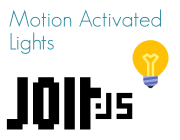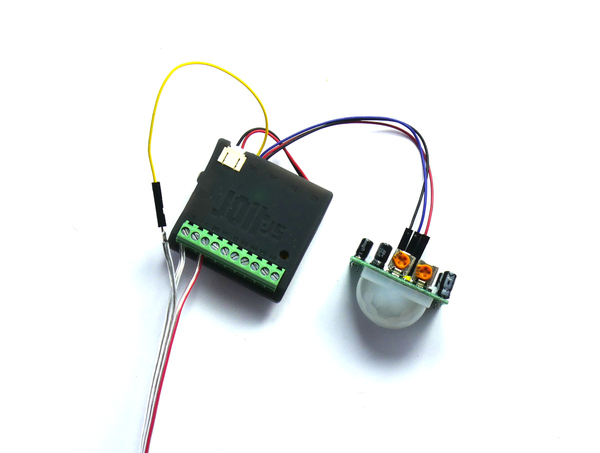
Jolt.js Motion Activated Lights
Sometimes it's really handy to have a motion activated light, but what if you want something a bit more interesting, that animates as it turns on or off?
For this you might use a Neopixel LED string but these draw a lot of power even when off. However Jolt.js's drivers can power the whole LED string, allowing it to last for ages on a battery.
At the end we'll also use the ble_led module to allow you to turn the light on and off wirelessly from Home Assistant
You'll Need
- A Jolt.js
- A Qwiic cable (supplied with Jolt.js)
- A Lithium Polymer battery (available in the Jolt.js Bundle)
- A Pyroelectric (PIR) Motion Sensor
- A Neopixel LED string - we're using some of Pimoroni's flexible wire here
Wiring Up
First, attach the LiPo battery - if you've got a battery with a JST connector of the right polarity you can plug it straight in.

Now to attach the Pyroelectric sensor. The standard HC-SR501 sensors come with a voltage regulator and diode attached, but this means they won't run well off of the Lithium Ion battery's lower voltage. To work around this, perform the simple low voltage modification shown in https://www.espruino.com/Pyroelectric#low-voltage-operation and you can then connect the sensor via the Qwiic connector. Take a Qwiic cable and wire as follows:
| Pyroelectric sensor | Qwiic cable |
|---|---|
| GND | GND (Black) |
| OUT | SDA (Blue) |
| VCC | VCC (Red) |
Now plug the Qwiic cable into Q0 on the Jolt.
Now you just need to attach the Neopixel string!
| Neopixel String | Jolt.js |
|---|---|
| GND | Terminal block 0 |
| DATA | Qwiic Cable SCL (Yellow) |
| 5V | Terminal block H0 |
Software
Let's test the Pyroelectric sensor. On the left-hand side of the IDE:
- Type
Q0.setPower(1)to turn the sensor on - Type
Q0.sda.read()repeatedly to read the status of the pin. For a few seconds after starting it will probably returntrue, thenfalseafter. Whenever movement is detected it should return true again. - Type
setWatch(e => LED2.write(e.state), Q0.sda, {repeat:true, edge:"both"});to turn on the green LED whenever the output is true - you can now fiddle with the potentiometer labelledSxon the sensor if you need to make it more/less sensitive.
Now to try out the LEDs.
- Type
H0.set()- this will turn on the string's power (and will by default automatically turn on Jolt.js's drivers) - Type
require("neopixel").write(Q0.scl, [20,0,0, 0,20,0, 0,0,20])- this should set the string's first 3 LEDs to different colours (likely green, red and blue - but it depends on your strip) - other LEDs after that may also light.
More information is on the Neopixel page but these lights take 3 bytes (24 bits) per pixel, so to make it easier to handle them we're using Uint24Array which is an Espruino-specific
array of 24 bit numbers. E.HSBtoRGB(..., 24) can also be used to get a 24 bit number representing a certain hue, saturation and brightness.
Now we can upload the software! Paste the following onto the right hand side of the IDE and click the Upload button:
// How long should the lights turn on after movement
const LIGHT_TIMEOUT = 30 * 1000; // 30 seconds
const LED_COUNT = 50; // number of LEDs we have
/* Uint24Array is unique to Espruino, but it allows us
to write to Neopixels where each pixel is 24 bits very efficiently */
var leds = new Uint24Array(LED_COUNT);
let isAnimating = false; // true if we're currently animating the LEDs
let animateToState; // if not undefined, we should animate to this new state right after
/// This function updates all the LEDs
function setLEDs() {
require("neopixel").write(Q0.scl, leds.buffer);
}
// Animate the lights on
function animateOn() {
isAnimating = true;
return new Promise(resolve => {
H0.set();
leds.fill(0);
var n = 0; // number of LED we're setting
var phase = 0; // which part of the animation are we on
const shootingStar = [ // shooting star - bright in the middle and trailing off
0x040000,
0x080000,
0x100000,
0x201010,
0x402020,
0x402020,
0x201010,
0x100000,
0x080000,
0x040000,
];
var interval = setInterval(() => {
if (phase==0) { // first phase is we have a 'shooting star' move from one end to the other
leds.set(shootingStar, n); // apply the shooting star
} else if (phase==1) { // second phase slowly light up all the LEDs
leds.fill(E.HSBtoRGB(0,0,0.25 * n / LED_COUNT,24)); // we only light LEDs 25% as they draw a lot of power!
} else { // now finish
clearInterval(interval);
isAnimating = false;
if (animateToState!==undefined) {
if (!animateToState) animateOff();
animateToState = undefined;
}
resolve();
}
setLEDs();
n++;
if (n>=leds.length) {
n=0;
phase++;
}
}, 20);
});
}
// Animate the lights off
function animateOff() {
isAnimating = true;
return new Promise(resolve => {
var n = 0; // number of LED we're setting
var phase = 0; // which part of the animation are we on
const left = [
0x000000,
0x040404,
0x080808,
0x101010,
0x202020
];
const right = left.slice().reverse();
var interval = setInterval(() => {
if (phase==0) { // first we slowly fade out the LEDs from each end
leds.set(left, n>>1);
leds.set(right, (leds.length-1)-(n>>1));
} else { // now finish
leds.fill(0);
H0.read(); // LEDs off
clearInterval(interval);
isAnimating = false;
if (animateToState!==undefined) {
if (animateToState) animateOn();
animateToState = undefined;
}
resolve();
}
setLEDs();
n++;
if (n>=leds.length) {
n=0;
phase++;
}
}, 25);
});
}
Q0.setPower(1); // turn on Pyroelectric sensor
let lightsOffTimeout; // the timeout that turns lights off after LIGHT_TIMEOUT
setWatch(e => {
// show state of PIR on green LED
LED2.write(e.state);
if (!e.state) return; // now we don't care about the falling edge
// motion detected!
if (lightsOffTimeout) {
// lights are already on - no need to turn them on again
clearTimeout(lightsOffTimeout);
} else if (isAnimating) {
// lights are currently turning off! Tell animateOff to turn them back on as soon as the animation has finished
animateToState = 1;
} else {
// else lights are off - animate on!
animateOn();
}
// after LIGHT_TIMEOUT from the last motion event, turn off!
lightsOffTimeout = setTimeout(function() {
lightsOffTimeout = undefined;
animateOff();
}, LIGHT_TIMEOUT);
}, Q0.sda, {repeat:true, edge:"both"});
You may want to change LED_COUNT to the number of LEDs you have.
Once uploaded:
- When movement is detected the LEDs will animate on
- After 30s they'll animate off, and any movement will make them, turn on again
Bonus - Home Assistant Integration
But, what if we wanted our lights to be controlled from Home Assistant?
We could use the LED BLE Library to make Jolt.js appear as a Bluetooth LED bulb that Home Assistant is aware of.
Just upload the following code instead, disconnect from Bluetooth and your light should appear in Home Assistant. See LED BLE Library for more information.
// How long should the lights turn on after movement
const LIGHT_TIMEOUT = 10 * 1000; // 60 seconds
const LED_COUNT = 50; // number of LEDs we have
/* Uint24Array is unique to Espruino, but it allows us
to write to Neopixels where each pixel is 24 bits very efficiently */
var leds = new Uint24Array(LED_COUNT);
let isAnimating = false; // true if we're currently animating the LEDs
let animateToState; // if not undefined, we should animate to this new state right after
let lightsOn = false; // current state of the lights
/// This function updates all the LEDs
function setLEDs() {
require("neopixel").write(Q0.scl, leds.buffer);
}
// Animate the lights on
function animateOn() {
if (isAnimating) {
animateToState = true;
return Promise.resolve();
}
isAnimating = true;
lightsOn = true;
return new Promise(resolve => {
H0.set();
leds.fill(0);
var n = 0; // number of LED we're setting
var phase = 0; // which part of the animation are we on
const shootingStar = [ // shooting star - bright in the middle and trailing off
0x040000,
0x080000,
0x100000,
0x201010,
0x402020,
0x402020,
0x201010,
0x100000,
0x080000,
0x040000,
];
var interval = setInterval(() => {
if (phase==0) { // first phase is we have a 'shooting star' move from one end to the other
leds.set(shootingStar, n); // apply the shooting star
} else if (phase==1) { // second phase slowly light up all the LEDs
leds.fill(E.HSBtoRGB(0,0,0.25 * n / LED_COUNT,24)); // we only light LEDs 25% as they draw a lot of power!
} else { // now finish
clearInterval(interval);
isAnimating = false;
if (animateToState!==undefined) {
if (!animateToState) animateOff();
animateToState = undefined;
}
resolve();
}
setLEDs();
n++;
if (n>=leds.length) {
n=0;
phase++;
}
}, 20);
});
}
// Animate the lights off
function animateOff() {
if (isAnimating) {
animateToState = false;
return Promise.resolve();
}
isAnimating = true;
return new Promise(resolve => {
var n = 0; // number of LED we're setting
var phase = 0; // which part of the animation are we on
const left = [
0x000000,
0x040404,
0x080808,
0x101010,
0x202020
];
const right = left.slice().reverse();
var interval = setInterval(() => {
if (phase==0) { // first we slowly fade out the LEDs from each end
leds.set(left, n>>1);
leds.set(right, (leds.length-1)-(n>>1));
} else { // now finish
leds.fill(0);
H0.read(); // LEDs off
clearInterval(interval);
isAnimating = false;
lightsOn = false;
if (animateToState!==undefined) {
if (animateToState) animateOn();
animateToState = undefined;
}
resolve();
}
setLEDs();
n++;
if (n>=leds.length) {
n=0;
phase++;
}
}, 25);
});
}
Q0.setPower(1); // turn on Pyroelectric sensor
let lightsOffTimeout; // the timeout that turns lights off after LIGHT_TIMEOUT
let forceLightOn = false; // lights are forced on by HomeAssistant
setWatch(e => {
// show state of PIR on green LED
LED2.write(e.state);
if (!e.state) return; // now we don't care about the falling edge
if (forceLightOn) return; // if lights are forced on, we don't care about motion
// motion detected!
if (lightsOffTimeout) {
// lights are already on - no need to turn them on again
clearTimeout(lightsOffTimeout);
} else {
// else lights are off - animate on!
animateOn();
}
// after LIGHT_TIMEOUT from the last motion event, turn off!
lightsOffTimeout = setTimeout(function() {
lightsOffTimeout = undefined;
animateOff();
}, LIGHT_TIMEOUT);
}, Q0.sda, {repeat:true, edge:"both"});
NRF.setTxPower(8); // highest power transmit
/* Make Jolt.js appear to be a Bluetooth LE Lightbolb that
HomeAssistant knows about */
require("ble_led").setup(function(state) {
if (state.on) {
// TODO: we could look at state.r/g/b and set colour accordingly!
forceLightOn = true;
if (lightsOffTimeout) clearTimeout(lightsOffTimeout);
lightsOffTimeout = undefined;
if (!lightsOn)
animateOn();
} else {
if (lightsOn) animateOff();
forceLightOn = false;
}
});
This page is auto-generated from GitHub. If you see any mistakes or have suggestions, please let us know.